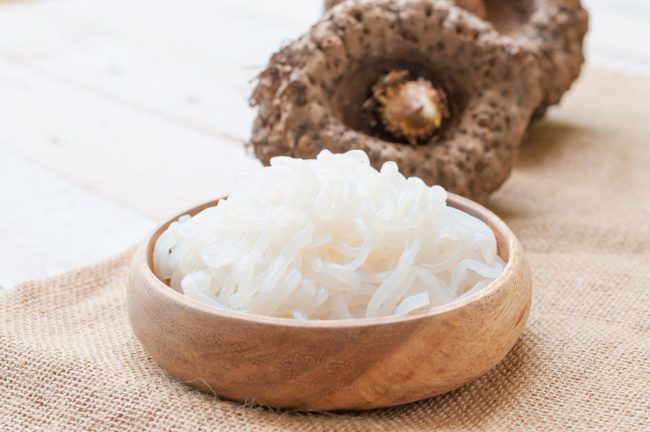Glucomannan is becoming increasingly popular as a natural weight loss aid and has even been officially recognised by the EU. Glucomannan is enjoying increasing popularity as a natural weight loss aid. Indeed, the fibre-rich root has been scientifically proven to significantly improve weight loss during dieting. We have examined glucomannan in detail, what side effects might be present and what should be considered when taking it.
What is Glucomannan?
Glucomannan has become a sensation recently, as it is considered a miracle cure for weight loss. Glucomannan, a water-soluble fibre, is extracted from the so-called konjac root. Konjac root is the tuber of the devil’s tongue (also called the tear tree, Amorphophallus Konjac or Amorphophallus Rivieri). It originates from East Asia, where it has been used for many years in medicine and cooking.
The special feature of glucomannan is that this fibre binds water in the body. This makes glucomannan ideal for a diet phase, where it is usually taken in capsule, powder or stick form. It is particularly important that glucomannan is obtained naturally and not artificially like other weight loss supplements. Glucomannan is generally known from Asian cuisine as glass noodles, made from Konjak root flour.
How can Glucomannan help you Lose Weight?
Glucomannan is a fibre with an extreme bulking capacity. It is able to bind 50 times the amount of water in relation to its own weight. This swelling effect quickly and permanently creates a feeling of fullness in the stomach. This effect is of course perfect for people who want to lose weight and who depend on a reduced calorie intake. It also helps to prevent cravings. The effectiveness of glucomannan has now been officially confirmed. According to EU Regulation 432/2012, glucomannan contributes to weight loss as part of a low-calorie diet, but requires a daily dose of 3 grams.
Other Benefits of Glucomannan
In addition to the fact that glucomannan contributes to weight loss, konjac root can do even more for our health:
- Reduction of cholesterol and blood lipids
- Controlling blood sugar levels
- Regulation and improvement of digestion and thus of the entire intestinal flora
- Prevention of insulin resistance
- Prevention of cancer
- Strengthening of the immune system
Side Effects of Glucomannan
Basically, glucomannan fibre is very well tolerated and in the event of an overdose of glucomannan, no harmful side effects are known. However, as with all other dietary fibres (e.g. wheat bran), digestive problems such as flatulence, abdominal pain, diarrhoea or nausea may occur. For this reason, it is recommended to gradually increase the dose to 3 grams per day. In this way, the body can slowly get used to the fibre intake and tolerate it better. In addition, it is very important to always drink enough liquid so that the glucomannan can go directly into the stomach where it is supposed to swell. As soon as the body gets used to the extra fibre, the first symptoms that may occur should disappear. When you eat glucomannan, make sure it goes into your stomach and does not get stuck in your throat. If it swells there, it can lead to choking.
As there is still no precise information about the effects on pregnant and breastfeeding women, it is not recommended to take it in these two cases. As glucomannan has an effect on blood sugar levels, it is best to avoid taking it if you have diabetes and to consult a doctor.
Dosage, Ingestion & Application
Whichever dosage form you choose, Glucomannan should always be taken before meals. It is best to take it half an hour before breakfast, lunch and dinner, as it generates a feeling of satiety and protection against unnecessary calories.
When taking it, it is important to drink between 300 and 500 millilitres of liquid, preferably water. Only then can the glucomannan swell properly. Overall, a dose of 3 grams per day is recommended, divided into 3 times 1 gram.
Glucomannan – In Capsule or Powder?
Glucomannan is available in many different forms to buy. In capsules, in sticks or even in powder. In France, most people take it in capsule form, as there is a small dosage and the capsules can be taken without problems on the road. In addition, it only swells in the stomach and should not be eaten like a cereal.
Care must be taken to ensure that the quality is good, as there are significant differences in quality between the products on offer. Well-known manufacturers use glucomannan extract in high doses in contrast to many cheap offers, which offer Konjac flour. Konjac flour contains a much lower proportion of pure glucomannan. The sticks are also interesting for travel and are sure to cover the needs. Alternatively, glucomannan is also available in powder form. This is particularly useful at home and is the cheapest option.
